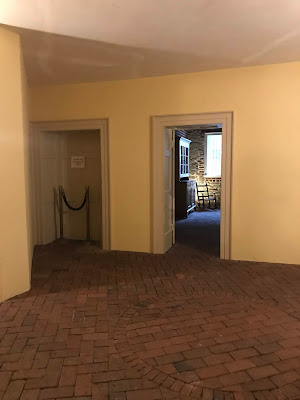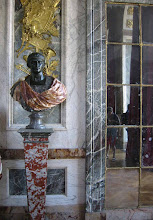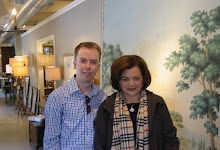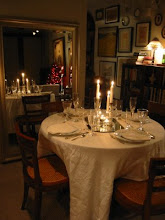Not only is the house open for free to the public, you typically have it to yourself to explore at your own pace (which I love). I promptly set up a later tour for our Mid-Atlantic branch of the ICAA with the help of a friend.
While the crisp details are certainly elegant, the true beauty lies in the plan (as always, click the image to see in more detail). While the site was rural AND waterfront when the house was built in 1799, early in Washington's history, the house is exceedingly urban. The architect, William Thornton, must have foreseen the city that would grow surrounding the house based on L'Enfant's plan.
Colonel John Tayloe III had the house built on the advice of his friend George Washington as his winter in-town residence and it remained as his families primary residence until 1855 at the death of his wife. The neighborhood was no longer fashionable and his children rented the house out; first as a girl's school, then to the Federal government as Naval offices, until it finally was a tenement. In 1898 the AIA stepped in (American Institute of Architects) to rent the house as their headquarters and in 1902 purchased the property. It is still owned and lovingly cared for by the AIA.
Let's step into the foyer shall we? All of the paint colors were matched to their 1810 appearance with help from Benjamin Moore and these colors are all available for purchase. The entry hall is 'Daytona Peach #079' for example.
The most striking feature of the round entry are a pair of English stoves flanking entry into the stairhall which feature neoclassic urns.Notice how even the doors match the curve of the walls -a lovely detail.
While we so often think of checkerboard floor tiles having to precisely match, the variation in the darker squares, made up of different marbles, is really soft and lovely.
The living room features the original moldings and Coade stone fireplace although the chandelier dates to the 1930s. The mantel was painted because when it arrived on site because the top shelf was missing. It was replaced in wood to match the stone mantel below. The wall colors in this room are not accurate as originally the room held wallpaper, although no one knows what it looked like!
The mirrors flanking the fireplace were original to the family and are original to the house. All of the other furnishings throughout the house are period but not original to the Tayloe family.
The central stairhall stands between the living and dining rooms (see plans above) but more on this later.
On the opposite side of the stairhall is the dining room. The lovely thing about the orientation of the house is that all rooms are bathed in natural light throughout the day.
The dining room also features an original Coade stone mantel. The green paint color is original to 1810 and is BM #480 Lily Pad, and #AF-475 Lush.
The brass hearth fenders are kept beautifully polished. All of the brasses would have been regularly polished to reflect the candlelight.
Stepping back into the stairhall notice the ivory "mortgage button" in the elegant newel. Of course the myth of this decorative feature is more interesting than actuality. There was no mortgage on this house when it was built!Heading up to the family quarters on the 2nd floor notice the curved walls continue. I love the sunny yellow paint colors - BM #319 Dalila.
This rather elegant jib door leads to one of many closets. This closet probably held the beds of the slaves who slept outside the doorways of the master bedroom.
The round room on top of the entry is the main family sitting room known as the Treaty Room. After the war of 1812 when the White House was burned by the British (in 1814), the Octagon House briefly served as the president's residence for President Madison and his wife Dolly. It was in this room that the president ratified the Treaty of Ghent which ended the war. The original table sits in the entry foyer of the house while this exact replica lets you take a closer look.
I love the simple wood mantels here on the 2nd floor.
Looking towards the rear you can see the stair going up to the 3rd floor where the children's bedrooms were (the Tayloe's had 15 children!) as well as an odd extension to a closet so that the stair and house appeared taller than they actually are: Sneaky!
However the best part of these houses in my opinion are the behind the scenes spaces. Adjacent to the elegant main stair is a rather clever triangular staircase that allows for more discreet access throughout the house and entry into the basement servants quarters.
The basement is actually quite bright with tall ceilings and large windows thanks to the service moat surrounding the house.
The central hall in the basement once held a round well for drinking and washing - you can see where it was in the round pattern in the brick. This area of Washington has always been marshy and the basement was always damp and battling water. The AIA undertook massive measures a few years ago to help prevent moisture from rising through the house and this floor was relaid.
As part of this work the original plaster had fallen off the brick bearing walls which absorbed water from the earth. While the brick dries out (over a few years) they are leaving the brick and stone exposed before re-plastering to its original appearance. That is a bread oven to the right of the main cooking fireplace and an early brick coal range to the left.
I love the brick wine storage shelves seen above. Similar arched brick shelves also exist at Homewood House in Baltimore of the same date which we toured this fall with the ICAA.
Returning outside you can see the brick walls which surround the service yard. The yard now contains the main AIA building finished in 1973 which surrounds, but respects by distance, the Octagon House. Notice the wall and chimney with oddly no windows (this is the wall of the dining room) making the house feel more like a townhouse; Possibly for future expansion that never occurred? I find it really surprising that while the city developed this property wasn't sold for development of townhouses adjoining the main house which would have fit nicely against these blank walls.
I highly encourage everyone to visit the Octagon House museum, open to the public free of charge Thursday through Saturday from 1-4, and otherwise by appointment. Group visits can be arranged, refer to their website here https://architectsfoundation.org/octagon-museum.
All photos my own with the exception of the first shot by Robert Tarasovich. Plans and drawings for HABS on wikicommons.















































.jpg)






















.JPG)







































































